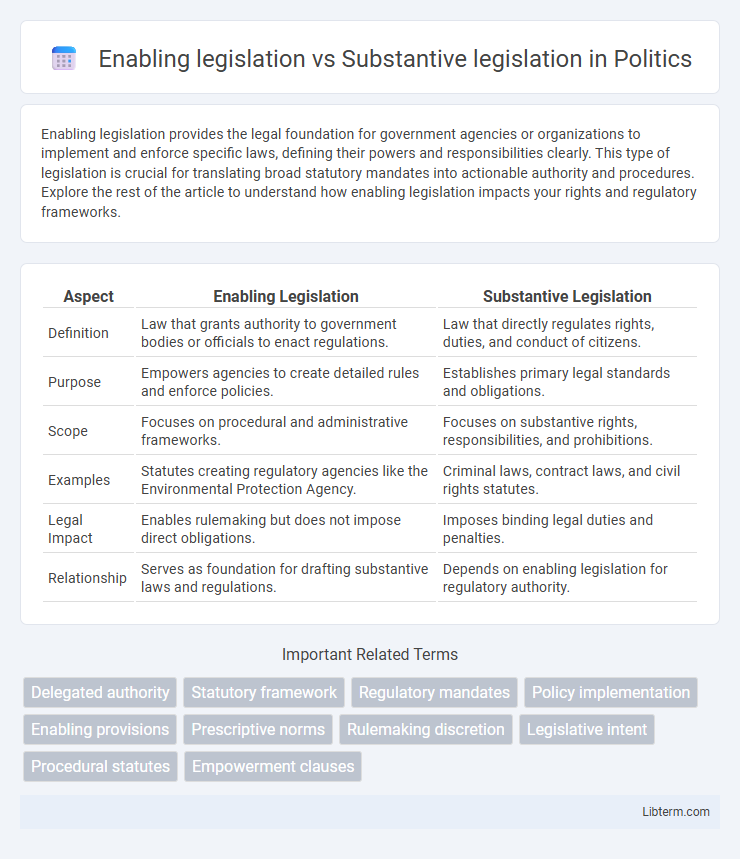Enabling legislation provides the legal foundation for government agencies or organizations to implement and enforce specific laws, defining their powers and responsibilities clearly. This type of legislation is crucial for translating broad statutory mandates into actionable authority and procedures. Explore the rest of the article to understand how enabling legislation impacts your rights and regulatory frameworks.
Table of Comparison
| Aspect | Enabling Legislation | Substantive Legislation |
|---|---|---|
| Definition | Law that grants authority to government bodies or officials to enact regulations. | Law that directly regulates rights, duties, and conduct of citizens. |
| Purpose | Empowers agencies to create detailed rules and enforce policies. | Establishes primary legal standards and obligations. |
| Scope | Focuses on procedural and administrative frameworks. | Focuses on substantive rights, responsibilities, and prohibitions. |
| Examples | Statutes creating regulatory agencies like the Environmental Protection Agency. | Criminal laws, contract laws, and civil rights statutes. |
| Legal Impact | Enables rulemaking but does not impose direct obligations. | Imposes binding legal duties and penalties. |
| Relationship | Serves as foundation for drafting substantive laws and regulations. | Depends on enabling legislation for regulatory authority. |
Introduction to Enabling and Substantive Legislation
Enabling legislation grants specific authority to government agencies or officials to enact rules and regulations within the framework of existing laws, serving as the foundation for administrative law. Substantive legislation defines the actual rights, duties, and prohibitions that govern individual and collective behavior, forming the core legal standards in society. Understanding the distinction between enabling and substantive legislation is crucial for interpreting the scope and impact of legal statutes.
Defining Enabling Legislation
Enabling legislation refers to laws passed by a legislative body that grant authority and define the scope for other entities, such as administrative agencies, to create rules or enforce regulations. This type of legislation establishes the legal framework and empowers institutions to implement specific policies or actions without detailing the substantive rules themselves. Distinct from substantive legislation, which directly outlines rights, duties, and prohibitions, enabling legislation primarily provides the procedural foundation for further regulatory development.
Defining Substantive Legislation
Substantive legislation defines the rights, duties, and obligations of individuals and entities, establishing the legal framework for behavior and relationships in society. It determines what is lawful or unlawful, specifying crimes, penalties, contracts, and property rights in clear terms. Unlike enabling legislation, which grants authority to governmental bodies to implement or enforce laws, substantive legislation directly addresses the substance of legal issues.
Key Differences Between Enabling and Substantive Legislation
Enabling legislation grants legal authority to government agencies, officials, or bodies to implement and enforce laws, defining their powers and scope of action. Substantive legislation establishes the actual rights, duties, and obligations of individuals and entities by creating, modifying, or extinguishing legal relationships. The key difference lies in their purpose: enabling legislation empowers and delineates authority, while substantive legislation shapes and governs legal conduct and relationships.
Functions and Purposes of Enabling Legislation
Enabling legislation grants government agencies or officials the authority to implement and enforce specific laws, providing the legal framework necessary for administrative actions and regulations. Its primary function is to delegate power, define the scope of authority, and ensure legal accountability in the execution of policies. Unlike substantive legislation, which establishes rights and duties, enabling legislation focuses on facilitating governance and operationalizing laws.
Functions and Purposes of Substantive Legislation
Substantive legislation establishes rights, duties, and obligations that define the legal relationships between individuals and entities, shaping how laws regulate behavior and resolve disputes. It serves to create, modify, or extinguish rights and liabilities, providing the foundation for justice and order within society. The primary function of substantive legislation is to delineate the legal framework that governs conduct, ensuring consistency, fairness, and protection of legal interests.
Legal Significance and Impact on Governance
Enabling legislation provides the legal authority for government agencies or officials to implement and enforce specific policies, establishing the framework and scope of regulatory power essential for governance. Substantive legislation defines the rights, duties, and obligations of individuals, directly shaping the legal relationships and societal norms that influence governance outcomes. The distinction impacts governance by determining whether laws authorize procedural actions or dictate core legal principles, affecting the balance of power and the effectiveness of legal enforcement.
Practical Examples of Enabling Legislation
Enabling legislation grants specific powers to government agencies or officials, such as the Clean Air Act allowing the Environmental Protection Agency (EPA) to regulate air pollution standards. Another example includes the Federal Communications Commission (FCC) receiving authority through the Communications Act of 1934 to oversee interstate telecommunications. These laws provide the necessary legal framework for implementing and enforcing substantive laws effectively.
Practical Examples of Substantive Legislation
Substantive legislation defines rights, duties, and legal relationships, such as criminal laws prohibiting theft or civil laws governing contracts, while enabling legislation grants authority to governmental agencies to enforce or implement these laws. Practical examples of substantive legislation include the Civil Rights Act, which prohibits discrimination based on race or gender, and the Environmental Protection Act, which establishes pollution control standards. These laws set clear legal standards and obligations, unlike enabling legislation which primarily establishes procedures and grants power.
Comparative Analysis: Implications for Lawmakers and Citizens
Enabling legislation grants specific authority to government agencies or officials to implement and enforce laws, shaping administrative processes and policy execution. Substantive legislation, on the other hand, defines the rights and duties of individuals, directly impacting societal behavior and legal relationships. Comparative analysis reveals that lawmakers must carefully balance enabling acts to avoid overreach while ensuring effective governance, whereas citizens rely on substantive laws for clear protections and obligations, highlighting the need for transparency and accountability in both types of legislation.
Enabling legislation Infographic

 libterm.com
libterm.com